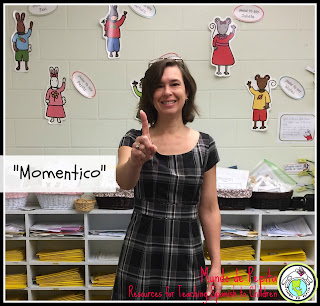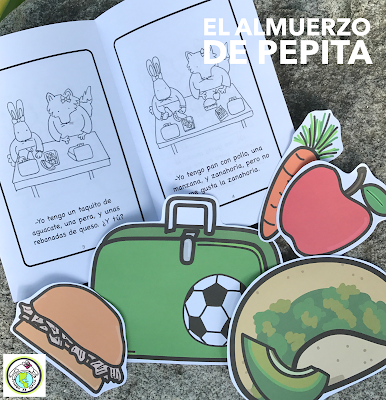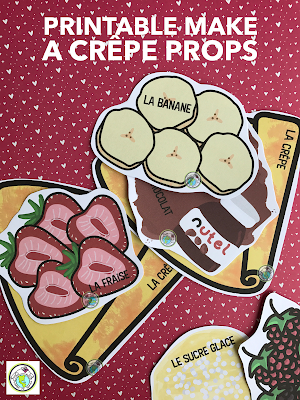ONE OF THE CHALLENGES I OFTEN HEAR FROM TEACHERS STRIVING FOR 90% IN THE TARGET LANGUAGE, as per ACTFL'S recommendation, is how to make vocabulary more comprehensible for students, especially NOVICE learners. Over the last few years, I've been creating a series of posts and tips in visual form to spark ideas and hopefully help in this process. I've collected many on my
Pinterest board here and you can click on my blog category 'Teaching 90% in the Target Language" to see all of my posts. I thought it might also be helpful to create a bulleted list of the prime strategies as a quick reference guide, which you can see below! Underneath, I've expanded on some of them to give a fuller explanation.
I've also listed a series of sites and apps I use to help me make visuals at the bottom- hope they are of help, and if you know of others, please share!
*VISUALS: As an illustrator myself, I am definitely convinced that visuals, whether they be pictures, photos, or physical props, are a strong support in helping get meaning across. I do think some visuals are better than others- as a very simple example: if the word is 'five' but the visual only shows ONE thing, that can be confusing to a language learner. In my opinion, a visual should clearly ILLUSTRATE (in other words, represent visually the word or concept) the meaning. I wrote a post which expands on this-
you can read it here :)
*GESTURES: We use a lot of familiar gestures in our day to day communication; utilizing those help get the meaning across without translating. Pointing, cupping your ear, using two fingers to point to your eyes, clapping, thumbs up, ok sign, rubbing your belly, tapping the side of your forehead, holding up your hand for 'stop', putting a finger to your lips, making a heart with your two hands, etc are all familiar gestures we use in the US. Signs from Sign language can also be a great option, especially for us elementary teachers who work in schools where the homeroom teachers use them too. One of my all time favorites is this below:

*DEMONSTRATE: I am a huge fan of demonstrating activities! By walking through an activity, even in an abbreviated fashion, provides our students with the overview of what is expected and how the activity is going to go. Some instances where I frequently use demonstrating: using our classroom materials, how to move about the classroom, clean up routine, games, partner activities, crafts, etc. A new strategy I am employing is creating videos of these demonstrations to show students when introducing games and other activities-this has been a great success!
*ACT IT OUT: Many words and situations lend themselves to being acted out- be creative! A prime example that almost stumped me last year: my classroom rug was being cleaned, so was out in the hallway. Using a piece of soap, I mimed cleaning it so my students could understand why it was out there and not in my room :)
*SIMPLIFY: Pare down what you want to say to the essential message. I think we, as teachers, unintentionally often add in more language than is really needed in the situation, making it more complicated for our students to comprehend. A perfect example I've shared many times before:
*COGNATES: Cognates are interesting because they are often more obvious to adults (the teacher) than to our students. And for pre-literate & early literacy students, even more so. I do not rely on utilizing cognates as a verbal strategy-my students rarely 'hear' the similarity. Rather, I write the cognate on the board, and cover a portion of the word to "reveal" the English.
*OPPOSITES: Our brains naturally categorize concepts such as opposites...leverage this process for all kinds of vocabulary!
*BREAK IT UP: This is another particular favorite of mine, in part because it also supports our students who have challenges with processing, recall, and following multistep instructions or activities. Instead of delivering a series of instructions and/or information in one go, break them up into steps and deliver each step one at a time, pausing after each (and/or making that chunk comprehensible) before moving on to the next. I wrote a post on
how to break up instructions this way here :)
*LEVERAGE KNOWN SCHEMA: Even little children are already familiar with a host of mental schema related to all kinds of things-when we leverage these, we allow the context to do a lot of the work for us. For example, most biographies contain predictable information: name, date of birth, location of birth and/or where he/she lived, their profession, etc. If you present this information in connection with a famous person, your students will be much quicker to intuit what you are talking about because they have a prior schema in their heads for this type of scenario. Non fiction is a bonanza for this! This also applies to all kinds of other things- known gestures, daily routines & activities, customs, images, etc. If I point to your shoelaces which are untied, and say in the target language 'tie your shoes', it is HIGHLY likely my kiddo will know what I am talking about because it's such a familiar context- there is no need for me to use English in this situation. If I show a heart next to a strawberry and put a big smile on my face, my kids automatically know I love strawberries!
*SPEECH & THINKING BUBBLES: I LOVE speech & thinking bubbles! One of the most effective ways I present the first person singular is through these visual supports. Like above, these are known schema-kids automatically know what they are for, so I don't have to explain this. I can then have the bubbles over their head, my head, a character's head, a classmate's head.... by moving the bubbles I can then reference what someone else is saying etc- and we all know that what's in the bubble is in first person.
There are many other strategies that work as well; I tried to take some of my most potent ones to share in this post. If you have others, please share in the comments!
SITES to help you create visuals for your classroom:
*Piktochart
*Canva
*Powtoon
*Picmonkey














